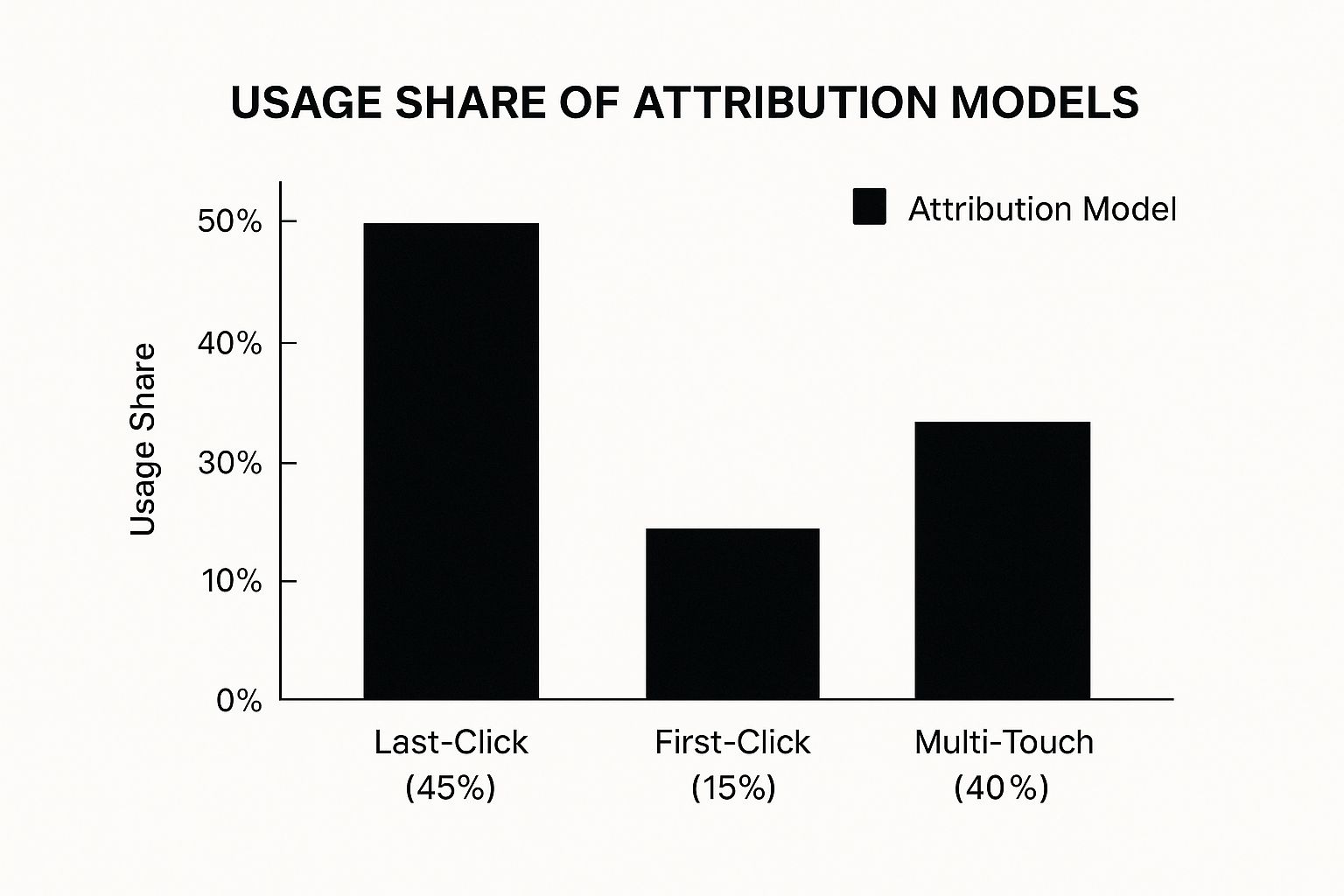Marketing Attribution Dashboard Guide: Data-Driven Success
Marketing Attribution Dashboard Guide: Data-Driven Success
Understanding Your Marketing Attribution Dashboard Foundation

Think of your marketing efforts like an orchestra. Each instrument (marketing channel) contributes to the overall performance. A marketing attribution dashboard is like the conductor, showing you how each channel contributes to the final conversion. This helps you identify high-performing channels, those needing adjustments, and refine your overall marketing strategy.
Beyond Last-Click: Unveiling the Customer Journey
Many marketers have traditionally relied on last-click attribution, giving full credit to the final click before a conversion. However, this approach ignores the impact of other touchpoints in the customer journey. For example, a customer might see your product on a social media ad, then find you again through organic search, and finally make a purchase after clicking an email promotion. A marketing attribution dashboard reveals the influence of each interaction. This provides a much clearer view of how customers interact with your brand.
Marketing attribution dashboards also go beyond basic metrics like clicks and impressions. They offer a combined view of customer interactions across all channels, including social media, email, paid search, and organic traffic. This comprehensive view helps you understand how channels work together to drive conversions. You might find, for example, that social media is great for brand awareness, while email marketing nurtures leads and closes sales. This insight helps optimize spending and channel strategy. You may also be interested in learning more about attribution models: How to master attribution model examples.
Why Your Business Needs a Marketing Attribution Dashboard
Marketing attribution dashboards are essential for marketers looking to optimize campaigns and boost ROI. Businesses using advanced marketing attribution models could see conversion rate increases of up to 30% by 2025 compared to those using traditional metrics. These dashboards offer a complete overview of customer interactions throughout the sales funnel. They compile data from multiple channels, including social media, email, paid search, and organic traffic. A key statistic shows that over 70% of marketers struggle to track multi-touch attribution manually, highlighting the value of these dashboards. Learn more about marketing attribution dashboard statistics here.
With this data, businesses can make better decisions about budget allocation and channel prioritization. A robust marketing attribution dashboard also helps improve campaign performance. It does this by pinpointing underperforming touchpoints and providing insight into which messages and creative elements resonate best with your audience. It's like having a detailed map of the customer journey to guide you towards better marketing decisions.
Building a Strong Foundation for Attribution Success
To truly benefit from a marketing attribution dashboard, it’s crucial to understand its core components. These tools offer much more than just visually appealing charts. They should drive decision-making and generate actionable insights. This is particularly vital in today's intricate marketing environment, where customers engage with brands across many channels and devices.
Moving past last-click attribution and embracing a more comprehensive understanding of the customer journey unveils valuable insights into what really motivates conversions. This enables marketers to make data-driven decisions, optimize campaigns for maximum ROI, and achieve better business outcomes overall. This sets a solid foundation for attribution success, positioning your business for continued growth within the dynamic marketing environment.
Essential Features Your Dashboard Must Have
Choosing the right marketing attribution dashboard with the right features can significantly impact your marketing success. This means understanding the essential capabilities that differentiate powerful attribution tools from basic reporting platforms. A robust dashboard empowers you to make informed decisions, rather than relying on guesswork.
Cross-Channel Integration: Connecting the Dots
Your marketing attribution dashboard should seamlessly integrate with all your marketing channels. This includes paid advertising platforms like Google Ads, Facebook Ads, email marketing software, social media platforms, and your website analytics. For example, if you're running campaigns across Google, Facebook, and email, your dashboard needs to capture data from all three sources to accurately assess their combined influence. Without complete integration, you're missing crucial pieces of the puzzle. To get a deeper understanding of different channels and their contributions, explore the use of multi channel attribution models.
Real-Time Data Processing: Staying Ahead of the Curve
In today's fast-paced marketing environment, real-time data is a necessity. Your dashboard needs to process data in real-time so you can quickly react to changing market conditions and optimize campaigns on the fly. For instance, if an ad campaign suddenly underperforms, real-time data lets you immediately identify the issue and adjust your strategy, preventing wasted budget. This agility is crucial for maximizing ROI.
Customizable Visualization: Making Data Actionable
Data is only useful if it's understandable. Your dashboard should offer customizable visualization options, allowing you to view data in a way that makes sense for your business. This could include charts, graphs, tables, and other visual representations of your key metrics. Customizable dashboards empower you to focus on the metrics that matter most, easily identifying trends and patterns.

This chart visualizes current attribution model usage. While Last-Click still holds a significant portion at 45%, Multi-Touch attribution is gaining ground at 40%, indicating a shift towards a more holistic understanding of the customer journey. First-Click attribution remains relevant for specific objectives at 15%.
Flexible Attribution Models: Choosing the Right Approach
Different businesses and campaigns require different attribution models. Your dashboard should offer a range of models, from basic last-click to more sophisticated multi-touch models like linear, time decay, and position-based. This flexibility allows you to choose the model that best aligns with your business objectives and provides the most accurate insights. For additional guidance on selecting the right tools, check out our guide on the best marketing attribution tools to boost your strategy.
Actionable Insights: Turning Data into Decisions
A good marketing attribution dashboard goes beyond simply presenting data; it provides actionable insights. This means identifying key trends, highlighting areas for improvement, and offering recommendations for campaign optimization. This empowers you to translate data into concrete actions that drive results.
To better illustrate the features and their impact, let's look at a comparison table:
Marketing Attribution Dashboard Features Comparison: This table compares essential features across different attribution dashboard types and their impact on marketing effectiveness.
| Feature | Basic Dashboard | Advanced Dashboard | Enterprise Solution | Business Impact |
|---|---|---|---|---|
| Cross-Channel Integration | Limited | Moderate | Extensive | Improved accuracy of attribution data |
| Real-Time Data Processing | Basic | Near Real-Time | Real-Time | Enhanced agility in campaign optimization |
| Customizable Visualization | Limited | Moderate | Highly Customizable | Clearer understanding of data trends |
| Flexible Attribution Models | Basic (Last-Click) | Several Models | Comprehensive Suite | More accurate insights based on business objectives |
| Actionable Insights | Basic Reporting | Performance Analysis | Predictive Recommendations | Data-driven decision making |
| Data Governance & Security | Basic | Advanced | Enterprise-Grade | Protection of valuable data |
Key takeaways from this comparison highlight the increasing benefits and sophistication as you move from basic to enterprise solutions. The level of detail and actionable insights directly impacts your ability to make effective marketing decisions.
Data Governance and Security: Protecting Your Investment
Your marketing data is valuable. Your dashboard should prioritize data governance and security with features like user access controls, data encryption, and regular backups. This protects your data from unauthorized access and potential loss, providing peace of mind and protecting your investment in data-driven marketing.
AI-Powered Attribution: Transforming Your Data Analysis

Traditional marketing attribution models can struggle with the complexities of today's customer journeys. These models rely on simplified rules. Often, they fail to accurately capture how different touchpoints influence customers, especially across multiple channels and devices. This is where AI-powered attribution comes in, providing a major improvement in data analysis. These advanced dashboards use machine learning algorithms to analyze large datasets and identify hidden patterns in customer behavior.
The Power of Predictive Analytics
AI-driven marketing attribution dashboards go beyond reporting past performance. They can predict future outcomes. This allows marketers to anticipate customer behavior changes and adjust strategies proactively.
For instance, imagine your AI-powered dashboard identifies a growing trend of mobile conversions from social media. This knowledge empowers you to optimize your mobile landing pages and social media campaigns for better results. This predictive capability is essential for maximizing ROI.
AI algorithms are also excellent at identifying the touchpoints with the greatest impact on conversions. This allows marketers to fine-tune budget allocation and prioritize channels for maximum efficiency.
The use of AI-driven marketing attribution is expanding rapidly. Forecasts indicate that by the end of 2025, about 60% of enterprises in major markets will have implemented AI or machine learning in their attribution dashboards. These AI-powered models analyze massive amounts of data from various touchpoints—much more accurately than traditional rule-based models. They adjust in real time to reflect changing customer behaviors. Find additional statistics here. For example, AI attribution can improve conversion source prediction accuracy by an average of 25%, enabling faster, data-driven decision making.
Real-Time Optimization: Adapting to the Dynamic Market
AI-powered attribution offers another key benefit: real-time adaptation to changing customer behavior. Traditional models require manual adjustments. However, AI dashboards automatically update their algorithms based on the latest data. This ensures your attribution insights stay accurate and relevant, even in a fluctuating market.
This constant optimization ensures efficient marketing budget allocation. For example, if a channel's performance suddenly declines, the AI dashboard can automatically reduce its weight and shift budget to more effective channels. This flexibility is essential for maximizing ROI in today’s ever-changing market.
Beyond the Numbers: Understanding Customer Behavior
AI-powered attribution delivers more than just numbers. It provides valuable insights into customer behavior. By analyzing the complex interactions across touchpoints, AI dashboards reveal the motivations, preferences, and pain points of your target audience.
This deeper understanding allows you to create more personalized and effective marketing campaigns. You can tailor your messaging, optimize the user experience, and build stronger customer relationships. These valuable insights can significantly enhance your marketing efforts and drive better results.
Setting Up Your Marketing Attribution Dashboard For Maximum Impact
A powerful marketing attribution dashboard isn't just about the technology. It's about strategic planning and careful implementation. This means connecting data sources, configuring the dashboard for insights, and establishing data governance.
Essential Integrations and Data Quality
First, integrate all your marketing platforms. This includes platforms like Google Ads and Facebook Ads, your CRM, email marketing software, and website analytics. Each source contributes to understanding the customer journey. Integrating everything provides a complete picture of how channels interact.
Good data is like a solid foundation for a house. It's essential. Clean and standardize your data before it enters the dashboard to avoid inaccuracies that can affect your analysis.
Tracking Conversions Across Channels
Conversion tracking is essential. It shows how different touchpoints influence your bottom line. Define your key performance indicators (KPIs) like leads, sales, and website conversions. Then, configure your dashboard to track these KPIs across each channel. This clarifies what's working and what isn't.
For example, if a customer interacts with your brand on social media, then clicks an email promotion before purchasing, your dashboard should track each interaction. This reveals each touchpoint's contribution to the customer journey.
Configuring Attribution Models Strategically
Different campaigns need different attribution models. Your dashboard should offer various options: first-touch, last-touch, linear, time decay, and custom models. The right model, or combination of models, provides the most accurate insights.
A last-click model credits the final touchpoint. A linear model distributes credit evenly across all touchpoints. Understanding your sales cycle and customer journey helps you choose the best model or combination for your business. Research shows structured setup processes lead to 73% faster time-to-value and 2.4x higher confidence in data accuracy. Learn more about attribution setup research.
Step-by-Step Guidance for a Smooth Setup
- Connect Data Sources: Integrate all relevant platforms.
- Establish KPIs: Define your most important metrics.
- Configure Conversion Tracking: Track accurately across all channels.
- Choose Attribution Models: Select models aligned with your sales cycle.
- Establish Data Governance: Implement protocols for data quality and security.
Following these steps ensures your dashboard provides reliable, actionable intelligence from the start. This prevents troubleshooting and maximizes your ROI. For more on AI, see this article: AI Will Be An Integral Part Of Your CS Tech Stack. A meticulous setup improves your insights and saves you time and resources. A well-configured dashboard empowers data-driven decisions and optimizes marketing strategies for maximum impact.
Optimizing Campaign Performance Through Attribution Insights

A marketing attribution dashboard provides the raw data you need, but its true value lies in interpretation and action. It's about moving beyond simply analyzing the data and using those attribution insights to optimize campaigns and drive measurable improvements. Let's explore how successful marketing teams transform dashboard data into actionable strategies.
Identifying Underperforming Touchpoints
Your marketing attribution dashboard helps pinpoint the weak points in your customer journey. For example, imagine discovering that a specific social media campaign is generating many clicks, but few conversions. This insight might suggest an issue with the landing page experience or the offer itself. Identifying these underperforming touchpoints allows for focused improvements and efficient resource allocation.
On the other hand, the dashboard can also reveal unexpected strengths. Perhaps a blog post you hadn't anticipated performing well is actually driving a significant number of leads. This allows you to invest further in proven successes and replicate winning strategies.
Budget Reallocation Based on True Value
Attribution dashboards empower you to allocate budget based on actual performance, not just guesses. By understanding which channels and touchpoints truly drive conversions, you can shift resources away from underperforming areas and toward those with the highest ROI. This data-driven approach maximizes your marketing spend and improves overall efficiency.
For example, if organic search delivers a higher ROI than paid advertising, you could reallocate budget from paid campaigns and invest more in SEO optimization. This strategic shift focuses your efforts where they are most effective.
Recognizing Predictive Patterns in Customer Behavior
A robust marketing attribution dashboard can reveal patterns that predict future customer behavior. Perhaps it shows that customers who engage with your blog content convert more often than those who only visit product pages. This insight allows you to prioritize blog content creation and promotion.
Understanding these predictive patterns lets you personalize your marketing, targeting specific customer segments with relevant messages and offers. This proactive approach improves engagement and drives conversion rates by addressing customer needs in advance.
Practical Optimization Techniques for Measurable Results
Successful marketing teams use attribution data to optimize various campaign elements:
- Creative Optimization: A/B test different ad creatives and landing page designs based on attribution insights to ensure your messaging and visuals truly resonate with your target audience.
- Audience Refinement: Segment your audience based on attribution data to create more targeted and effective campaigns, perhaps focusing on specific demographics, interests, or behaviors.
- Channel Strategy Adjustments: Shift budget and resources between channels based on their contribution to conversions to ensure maximum ROI from every channel.
Measuring Optimization Impact on ROI
Tracking the impact of your optimization efforts is crucial. Your marketing attribution dashboard helps you measure the results of your changes and quantify their impact on your overall marketing ROI.
The following table, "Attribution-Based Optimization Strategies and Results," presents performance data showing improvement metrics from different attribution-driven optimization approaches across various marketing channels.
| Optimization Type | Attribution Insight | Implementation Method | Average Improvement | Time to Impact |
|---|---|---|---|---|
| Creative Optimization | Low conversion rates from a specific ad creative | A/B testing new creatives | 15% increase in conversion rate | 2 weeks |
| Audience Refinement | High conversion rates from a specific demographic | Targeting campaigns to that demographic | 10% increase in ROI | 1 month |
| Channel Strategy Adjustment | Low ROI from a specific channel | Reallocating budget to higher-performing channels | 20% increase in overall marketing ROI | 2 months |
This table demonstrates how using attribution insights to inform optimization strategies can significantly impact marketing performance and lead to measurable business growth. Consistently review and refine your strategies based on ongoing data analysis to maintain optimal results. Learn more about overcoming marketing attribution challenges. By utilizing these techniques, your marketing team can harness the power of attribution to improve campaign performance and maximize ROI.
Avoiding Common Attribution Dashboard Failures
A marketing attribution dashboard can be a powerful tool for understanding your customer journey and optimizing your marketing spend. However, even with the best dashboard software, implementation can fall short if you don't address common pitfalls. This means understanding potential data quality issues, integration challenges, and organizational roadblocks that can undermine your success.
Data Quality: The Foundation of Accurate Attribution
Imagine building a house on a shaky foundation. It won't last. Similarly, a marketing attribution dashboard relies on high-quality data. Inaccurate or incomplete data leads to flawed insights and poor decisions. Data quality is paramount for successful attribution.
One common issue is inconsistent data formatting. For example, if some systems track conversions as "Sales" while others use "Orders," your dashboard will struggle to provide an accurate picture. Standardizing data formats across all sources is essential.
Another challenge is missing data. If your CRM system doesn't capture all website visits or interactions from certain marketing channels, your attribution data will be incomplete. Ensuring complete data capture from all touchpoints is crucial. You might be interested in: How to master marketing attribution challenges.
Integration Challenges: Connecting the Dots
Even with clean data, integration issues can hinder your attribution efforts. Your dashboard needs to connect with all your marketing platforms, from Google Ads to your CRM. Any gaps in integration create blind spots in your data.
For example, if your email marketing platform isn't integrated, the dashboard won't capture the role of email in the customer journey. This can lead to underestimating email's contribution and misallocating marketing resources. Thorough integration across all channels is key.
Organizational Resistance: Overcoming Internal Hurdles
Implementing a new marketing attribution dashboard often requires changes in workflows and reporting. This can sometimes lead to resistance from team members used to older methods. Addressing these organizational challenges is crucial for adoption.
One common obstacle is lack of training. If team members don't understand how to use the dashboard or interpret the data, they’re less likely to use it. Providing comprehensive training and support is essential for success.
Another challenge is unrealistic expectations. Some stakeholders may expect immediate results from the dashboard. It's important to set realistic expectations and emphasize that attribution is an ongoing process of learning and optimization. This requires patience and a commitment to continuous improvement.
Building a Sustainable Attribution Process
To avoid these failures, focus on building a sustainable attribution process. This means establishing clear data governance protocols, providing ongoing training, and fostering a culture of data-driven decision-making. These steps ensure your marketing attribution dashboard delivers long-term value.
Here's a checklist for attribution success:
- Data Quality: Implement data standardization and validation processes.
- Integration: Ensure seamless integration across all marketing platforms.
- Training: Provide comprehensive training for all team members.
- Expectations: Set realistic expectations with stakeholders.
- Optimization: Establish a process for ongoing review and improvement.
By addressing these critical areas, you can avoid common attribution dashboard failures and empower your team to make informed decisions, optimize campaigns, and maximize marketing ROI.
Ready to transform your marketing attribution? LeadPulse helps you understand where your leads and customers are coming from. Get started with LeadPulse today!